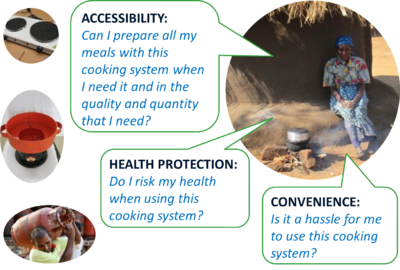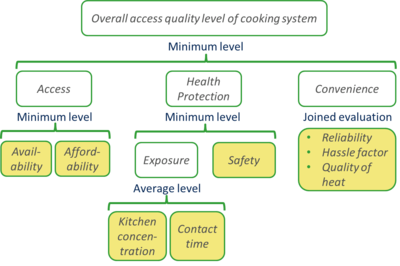Click here to register!
Cooking Energy System (CES) Evaluation
Background
The fuels and technologies used by households for their daily cooking have become a major global issue in the energy access, gender as well as health debate. Global targets aim for universal access to modern, clean and efficient cooking energy. The outstanding challenge is, however, not only providing access but also evaluating results and progress.
The 2030 Agenda for Sustainable Development applies the Sustainable Development Goal (SDG) indicators. The SDG 7 indicator 7.1.2 reads “Proportion of population with primary reliance on clean fuels and technology”. WHO, developing the methodology, defines “clean” based on the WHO Indoor Air Quality Guidelines. This binary approach – clean versus polluting – is based on fuel and stove performance.
The Sustainable Energy for All (SEforAll) platform supports and facilitates universal access to modern energy services by 2030 (SDG 7.1). According to the Global Tracking Framework (GTF) 2017, published by the World Bank (WB), newly provided access to clean fuels and stoves cannot compete with the population growth of the most affected countries in Africa and Asia.
In order to fill information gaps of SDG and GTF binary access measurement, the Multi-Tier Framework (MTF, published by WB, ESMAP in 2015) redefines energy access as spectrum of energy access service levels experienced by beneficiaries. The MTF for cooking reflects six key attributes (indoor air quality, efficient heat, convenience, safety, affordability, and fuel availability) and differentiates each with six service quality levels. EnDev intensively contributes to the MTF revision with the EnDev Cooking Energy System (CES) Evaluation approach.
Cooking Energy System (CES)
Figure 1: Contextualising the performance assessment = Cooking Energy System
EnDev developed the CES evaluation approach, which – similarly to the MTF – takes into account the transitional character as well as the complexity of improving access to cooking energy services. Improving the cooking situation in the sense of CES means: considering fuel quality or even switching fuel, improving cooking devices and cooking equipment, adjusting user behaviour and cooking practices as well as increasing ventilation and modifying the kitchen.
Generally, internationally discussed measurement approaches differ. While some assessments are mainly based on stoves and laboratory test results, others – like the CES – evaluate quality and effects of access to cooking energy based on field-based approximations and household surveys. EnDev considers the most important factors of many dimensions of the cooking context and the interaction of factors determining the impact experienced by beneficiaries: fuel, stove, user, and kitchen.
Evaluation Approach
The CES approach was developed to bridge the gap from one-dimensional judgements based on laboratory stove tests to the actual real-life usage situation. The three key questions answered by the CES are: Is the fuel accessible? Does the CES protect people’s health? Is the CES convenient?
Figure 2: Dimensions of CES quality
These dimensions are broken down into a comprehensive set of assessment parameters and an evaluation framework. Overall accessibility is determined by the minimum level of both fuel availability and affordability. Health protection is determined by safety and exposure, which again depends on kitchen concentration and the contact time with pollutants. Convenience is a combination of reliability, hassle factor and quality of heat provided by the cooking system.
Figure 3: Overall ranking according to the CES
Similar to the MTF EnDev applies six access quality levels for each dimension, to describe the relative improvements compared to baseline technologies. The approach intends to reflect the real-life situation and takes into account the phenomena of stove stacking (using different stoves for different purposes), fuel stacking (using different fuels depending on seasonal availability) and stacking of cooking location (cooking can happen inside, outside, both, depending of season and cultural context). Therefore, the method also allows for describing the quality levels of CES in relation to the baseline scenario.
EnDev builds the CES approach on both its rich field-based experiences gained in country projects and globally and on research-based findings exchanged in the international cooking energy sector. The particularity of the CES approach is the introduction and use of proxies to determine access quality. Combined with household survey results and field studies these proxies will be verified and validated over time.
Implementation and Outlook
After working on the CES evaluation concept between 2015 and 2016, data collection tools are being developed and piloted in 2017. EnDev currently develops an EnDev survey based set of tools (including questionnaires and evaluation tools) to standardise the CES evaluation. In 2017, the first EnDev country projects are going to pilot this methodology in the field.
The verification of the hypothesis underlying the proxies needs to be provided over the next years. EnDev acknowledges that field studies might lead to adjustments of the evaluation and interpretation of the different proxies. For instance for exposure EnDev Senegal and EnDev Benin are carrying out field studies to assess the influencing factors of ventilation, place of cooking, fuel quality, stove etc.
In future, EnDev envisions developing additional “social indicators” such as climate protection, sustainability of the energy source, and energy efficiency.
Further Information
Find more information in the CES evaluation apporach paper, available here.
- Cooking energy portal on energypedia
- Cooking energy compendium on energypedia
- The Cooking Energy System on energypedia
- Energy and the Sustainable Development Goals on energypedia






















